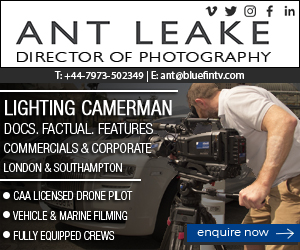Broadcast News
01/09/2016
Broadening Our Crew Networks

Over the summer I camera-operated on several jobs that consolidated my view that camera crews continually need to adapt their skills to take advantage of the digital landscape, says Sean Russell, Freelance Lighting Cameraman.
The events were the Queens 90th Birthday celebrations, the June EU Referendum and a live streamed Orchestral performance relayed to New York. What struck me most working on these events was not our camera set up of multiple cameras and multiple locations, but that of our distribution of signals. I am always aware of a production's transmission routes of either a links truck, DSNG, flyaway or fibre point. However on these particular jobs, in conjunction with the traditional paths, we employed Ka-Sat units and Live-U 4G encoders.
The introduction of new distribution technology is not in itself transforming, but it was the size, cost and potential multi-point distribution that caught my eye. I am not the first cameraman to see potential in uplinking services. Several cameramen I have known over the years have jumped the fence to set up SNG vehicles and manage fly-away services, but with their moves came a lot of expense, acquisition of technical knowledge and a constant flow of encoder/decoder upgrading & equipment redundancy. The introduction of Ka-sat technology appears to have broken the mould and is now liberating the transmission and distribution chains.
In my experience 4G broadband distribution of video only goes partway in meeting the needs of some users but not for Live Event transmission. During times of heavy traffic and multiple users at an event the broadband service is shared and consequently transmission data rates drop and are not dependable. Some broadcasters may accept the risk of dropout, locking up or latency problems when used on breaking news stories. However for an owner operator to on-sell it as a live streaming service on a routine shoot is a risk. Irrespective of the number of pathway bonding guarantees the encoders suggest. The problem is not necessarily the encoding unit but that of the network that supports it. There is also a potential headache on the horizon using the 3G/4G networks sending video. It stems from the limiting availability to individuals, who are required to give personal details when buying multiple SIM cards, in Switzerland, France and Belgium. This is due to security efforts in prevention of terrorist activity. In the UK it's presently not a problem but when crews are working abroad it makes sense to purchase local SIM cards to reduce costs. A possible answer in circumventing this and ensuring reliability of data transfer is using uncontested pathways. No sharing! This is where Ka-Sat technology is providing a step change.
On the EU referendum job I was further surprised when a camera colleague of mine told me he had just taken delivery of a new Ka-Sat dish. He was now adding portable broadband distribution as a service to his camera kit. Further surprise was added, when he informed me of two other camera colleagues who had also bought units. Their epiphanies took hold amidst the refugee crisis in Greece last Autumn. Whilst waiting for boats to appear on the beaches they were transmitting packages and live links via 4G data networks, but these were not reliable. They saw the instant value in the cheaper, portable and quick setup Ka-Sat technology. The value was not only in a more robust and reliable transmission of the signal but of the backhauling of talkback, IFB, station pictures, VoIP telephony and internet access. The units also have a built in Wi-Fi network and IP address. The primary use of the unit is based in its high data rate signal transmission; the satellites operating this Ka frequency range are known as High Throughput Satellites (HTS). Not as a Digital Video Broadcast Service (DVBS) link but that of a lower cost data sender. The European Ka Sat coverage was developed and operated by Eutelsat. It works on a multi-beam (82 spots) network, centralising its footprint coverage over Europe and the Mediterranean basin which includes North Africa and parts of the Middle East.
The system is more versatile and accessible to camera and production crews than previous dish setups. Since the late 1980s I have had access to Inmarsat satellite or B-Gan, store & forward technology but their versatility in video sending was always limiting. I found using a Ka-Sat dish remarkably easy to set up, align and use. The units do not require licences to operate in Europe, and with most manufacturers aiming to condense all its components into a single 23kg travel box, it is truly portable. They boast a 10 minute setup and from the times I have had with them, that is a fair reflection.
What's more is power consumption; some models operate on two V-lock 12 volt DC batteries. So for camera crews with very little spare space in their cars/crew vans it is very much now in the realms of possibility and one which will not greatly distract from their principal job of camera work. For some crews this introduction and addition to their production kit may well be an added distraction but I suspect for many working in a news environment and live corporate events that they may well see this as an opportunity to provide a value added service. One which is cost effective. A guide price for a working fixed location Ka-Sat kit with a pressed steel 76 cm dish can be found below £1,000. Flyaway versions vary in price between £3,000 to £10,000. AKD Sat-Comm offer an impressive and rugged 75 cm carbon fibre petal dish, employing a sound peaking alarm for satellite finding.
As with everything in life there are areas where things fall short. The first is that it suffers from rain fade, so in times of heavy cloud cover and rainfall the signal deteriorates. However the technology does try to compensate for this by reducing bit rates and introducing compression algorithms. To mitigate the rain fade some operators opt for a 1.2 metre dish system.
In addition, the way in which the uncontested space segment is sold and managed is frustrating. It is booked in 15-minute segments with each session starting upon the hour, 15 past, half past and a quarter to. Presently, booking additional minutes less than 15 minutes is not possible and irksome. Consequently you overestimate the time required to compensate for any over run. For operators not fussed about exclusive pathways they can just point turn on and distribute data via the terminal without a booking. But similar to the broadband networks, you share the space and data rates are reduced to an average 2.5 Mb/ps as opposed to a guaranteed 6 Mb/ps with a booked uncontested segment. This open un-booked space use is called 'Best Effort' and the pricing structure remains the same as uncontested bookings. The difference being slower data rates but these for a crew on the ground are not an issue if they are just sending packages or live video with no studio to location presenter link ups; but if you know there is to be a presenter link up, then book uncontested space. It's a case of horses for courses. Tthe same debate arises whether you send data via established Wi-Fi networks, SIM card bonding on a 4G network or Ka-Sat. We now have the elements to tailor our medium of delivery with regards to costs, time and quality.
Because the system runs on a smaller dish and use higher frequencies the unit must be stable. If mounted on a vehicle it would benefit from support jacks as any movement of the vehicle throws the signal off causing a loss of connection. This is due to the movement causing a signal degradation. In Ku Band this just means a decrease in signal to noise but in Ka Band it causes the modem to drop out and it's the reboot of the modem that causes the signal outage.
Much of these downsides are easily outweighed by the value added it affords location camera crews and corporate events.
The take up of the Ka-Sat technology and multi-spot beam is spreading across the globe with satellite operators such as Hughes, Viasat, and Eutelsat looking to globally spread the system, eventually creating a network as broad and more concentrated than the existing and over-saturated Ku-Sat network. The Ka-Sat technology and expanded coverage is the method airlines are pinning their hopes on in providing inflight Wi-Fi, and entertainment streaming.
I do not wish to addle my brain with data algorithms and compression rates but camera technology has already forced me down that route and getting to technical grips with Ka Sat really is a rather small leap. Companies and individuals considering how to add services or change their business model, it really is something to take a look at.
Without getting hung up on data rates and picture quality for those already using existing broadband technology for delivery, this makes you truly portable and self sufficient. It provides a means for establishing a broadband hub anywhere. This reduces dramatically the backhaul costs for broadcasters and gives a provider an additional revenue stream that before was the preserve of specialist uplink suppliers.
Until this point I have reflected upon the technology, but what also struck me over the course of the events I worked on was the evolution of the multi-point distribution network. Earlier this year I was asked if I would consider being a contributor to a joint service trial by LiveU and Associated Press Television. The notion was for me to use the encoder system to deliver video back to my clients from the field using the 4G network or Ka-satellite and distributing via a managed server or cloud.
The aim is to create a network of content providers and content receivers which can be grouped together and start a dialogue. This to me seems to be a major step change from the EBU news exchange system for content delivery. It will directly connect the content provider with a multitude of content consumers. Where each download can be tracked and billed. With regards to camera crew independently providing coverage, it opens up a much bigger customer base. For my mind this is truly bringing about the democratisation of content provision and distribution networks. The network of customers needs to be managed from a central hub whereby uploaded footage is processed through a server ready for live or draw down or at a later time by others who have agreed to the multipoint distribution licences. This is the space where Associated Press Television are placing themselves.
Like most online communities your reputation is gained and enhanced by others in the community. I still believe broadcasters would want to vet crews they are commissioning and not book solely on availability, although a crew with a delivery system can be enticing.
Reflecting on my summer's live event crewing meant that I have now changed my opinion on signal distribution. During my years working alongside triax, fibres, microwave links, Cannobeams, C-band and Ku band uplinks, any talk or suggested inspection of signal distribution I managed to find time to go and have a cup of tea, but this year I have become engrossed in its development.
I have realised that the technology is now relevant to me and to what I do. It has brushed aside so many previous deterring factors such as size, assembly, affordability, redundancy and specialist user knowledge. As a system it can now fit into a conversation with a commissioning editor or production manager without descending into anxiety laden technical papers discussion.
The system's versatility and network distribution does hearten me and should my career in broadcast start to falter I can perhaps hop over into ad-hoc mobile broadband, Wi-Fi and VoIP distribution at events or even just hire it out.
www.srcamera.com
The events were the Queens 90th Birthday celebrations, the June EU Referendum and a live streamed Orchestral performance relayed to New York. What struck me most working on these events was not our camera set up of multiple cameras and multiple locations, but that of our distribution of signals. I am always aware of a production's transmission routes of either a links truck, DSNG, flyaway or fibre point. However on these particular jobs, in conjunction with the traditional paths, we employed Ka-Sat units and Live-U 4G encoders.
The introduction of new distribution technology is not in itself transforming, but it was the size, cost and potential multi-point distribution that caught my eye. I am not the first cameraman to see potential in uplinking services. Several cameramen I have known over the years have jumped the fence to set up SNG vehicles and manage fly-away services, but with their moves came a lot of expense, acquisition of technical knowledge and a constant flow of encoder/decoder upgrading & equipment redundancy. The introduction of Ka-sat technology appears to have broken the mould and is now liberating the transmission and distribution chains.
In my experience 4G broadband distribution of video only goes partway in meeting the needs of some users but not for Live Event transmission. During times of heavy traffic and multiple users at an event the broadband service is shared and consequently transmission data rates drop and are not dependable. Some broadcasters may accept the risk of dropout, locking up or latency problems when used on breaking news stories. However for an owner operator to on-sell it as a live streaming service on a routine shoot is a risk. Irrespective of the number of pathway bonding guarantees the encoders suggest. The problem is not necessarily the encoding unit but that of the network that supports it. There is also a potential headache on the horizon using the 3G/4G networks sending video. It stems from the limiting availability to individuals, who are required to give personal details when buying multiple SIM cards, in Switzerland, France and Belgium. This is due to security efforts in prevention of terrorist activity. In the UK it's presently not a problem but when crews are working abroad it makes sense to purchase local SIM cards to reduce costs. A possible answer in circumventing this and ensuring reliability of data transfer is using uncontested pathways. No sharing! This is where Ka-Sat technology is providing a step change.
On the EU referendum job I was further surprised when a camera colleague of mine told me he had just taken delivery of a new Ka-Sat dish. He was now adding portable broadband distribution as a service to his camera kit. Further surprise was added, when he informed me of two other camera colleagues who had also bought units. Their epiphanies took hold amidst the refugee crisis in Greece last Autumn. Whilst waiting for boats to appear on the beaches they were transmitting packages and live links via 4G data networks, but these were not reliable. They saw the instant value in the cheaper, portable and quick setup Ka-Sat technology. The value was not only in a more robust and reliable transmission of the signal but of the backhauling of talkback, IFB, station pictures, VoIP telephony and internet access. The units also have a built in Wi-Fi network and IP address. The primary use of the unit is based in its high data rate signal transmission; the satellites operating this Ka frequency range are known as High Throughput Satellites (HTS). Not as a Digital Video Broadcast Service (DVBS) link but that of a lower cost data sender. The European Ka Sat coverage was developed and operated by Eutelsat. It works on a multi-beam (82 spots) network, centralising its footprint coverage over Europe and the Mediterranean basin which includes North Africa and parts of the Middle East.
The system is more versatile and accessible to camera and production crews than previous dish setups. Since the late 1980s I have had access to Inmarsat satellite or B-Gan, store & forward technology but their versatility in video sending was always limiting. I found using a Ka-Sat dish remarkably easy to set up, align and use. The units do not require licences to operate in Europe, and with most manufacturers aiming to condense all its components into a single 23kg travel box, it is truly portable. They boast a 10 minute setup and from the times I have had with them, that is a fair reflection.
What's more is power consumption; some models operate on two V-lock 12 volt DC batteries. So for camera crews with very little spare space in their cars/crew vans it is very much now in the realms of possibility and one which will not greatly distract from their principal job of camera work. For some crews this introduction and addition to their production kit may well be an added distraction but I suspect for many working in a news environment and live corporate events that they may well see this as an opportunity to provide a value added service. One which is cost effective. A guide price for a working fixed location Ka-Sat kit with a pressed steel 76 cm dish can be found below £1,000. Flyaway versions vary in price between £3,000 to £10,000. AKD Sat-Comm offer an impressive and rugged 75 cm carbon fibre petal dish, employing a sound peaking alarm for satellite finding.
As with everything in life there are areas where things fall short. The first is that it suffers from rain fade, so in times of heavy cloud cover and rainfall the signal deteriorates. However the technology does try to compensate for this by reducing bit rates and introducing compression algorithms. To mitigate the rain fade some operators opt for a 1.2 metre dish system.
In addition, the way in which the uncontested space segment is sold and managed is frustrating. It is booked in 15-minute segments with each session starting upon the hour, 15 past, half past and a quarter to. Presently, booking additional minutes less than 15 minutes is not possible and irksome. Consequently you overestimate the time required to compensate for any over run. For operators not fussed about exclusive pathways they can just point turn on and distribute data via the terminal without a booking. But similar to the broadband networks, you share the space and data rates are reduced to an average 2.5 Mb/ps as opposed to a guaranteed 6 Mb/ps with a booked uncontested segment. This open un-booked space use is called 'Best Effort' and the pricing structure remains the same as uncontested bookings. The difference being slower data rates but these for a crew on the ground are not an issue if they are just sending packages or live video with no studio to location presenter link ups; but if you know there is to be a presenter link up, then book uncontested space. It's a case of horses for courses. Tthe same debate arises whether you send data via established Wi-Fi networks, SIM card bonding on a 4G network or Ka-Sat. We now have the elements to tailor our medium of delivery with regards to costs, time and quality.
Because the system runs on a smaller dish and use higher frequencies the unit must be stable. If mounted on a vehicle it would benefit from support jacks as any movement of the vehicle throws the signal off causing a loss of connection. This is due to the movement causing a signal degradation. In Ku Band this just means a decrease in signal to noise but in Ka Band it causes the modem to drop out and it's the reboot of the modem that causes the signal outage.
Much of these downsides are easily outweighed by the value added it affords location camera crews and corporate events.
The take up of the Ka-Sat technology and multi-spot beam is spreading across the globe with satellite operators such as Hughes, Viasat, and Eutelsat looking to globally spread the system, eventually creating a network as broad and more concentrated than the existing and over-saturated Ku-Sat network. The Ka-Sat technology and expanded coverage is the method airlines are pinning their hopes on in providing inflight Wi-Fi, and entertainment streaming.
I do not wish to addle my brain with data algorithms and compression rates but camera technology has already forced me down that route and getting to technical grips with Ka Sat really is a rather small leap. Companies and individuals considering how to add services or change their business model, it really is something to take a look at.
Without getting hung up on data rates and picture quality for those already using existing broadband technology for delivery, this makes you truly portable and self sufficient. It provides a means for establishing a broadband hub anywhere. This reduces dramatically the backhaul costs for broadcasters and gives a provider an additional revenue stream that before was the preserve of specialist uplink suppliers.
Until this point I have reflected upon the technology, but what also struck me over the course of the events I worked on was the evolution of the multi-point distribution network. Earlier this year I was asked if I would consider being a contributor to a joint service trial by LiveU and Associated Press Television. The notion was for me to use the encoder system to deliver video back to my clients from the field using the 4G network or Ka-satellite and distributing via a managed server or cloud.
The aim is to create a network of content providers and content receivers which can be grouped together and start a dialogue. This to me seems to be a major step change from the EBU news exchange system for content delivery. It will directly connect the content provider with a multitude of content consumers. Where each download can be tracked and billed. With regards to camera crew independently providing coverage, it opens up a much bigger customer base. For my mind this is truly bringing about the democratisation of content provision and distribution networks. The network of customers needs to be managed from a central hub whereby uploaded footage is processed through a server ready for live or draw down or at a later time by others who have agreed to the multipoint distribution licences. This is the space where Associated Press Television are placing themselves.
Like most online communities your reputation is gained and enhanced by others in the community. I still believe broadcasters would want to vet crews they are commissioning and not book solely on availability, although a crew with a delivery system can be enticing.
Reflecting on my summer's live event crewing meant that I have now changed my opinion on signal distribution. During my years working alongside triax, fibres, microwave links, Cannobeams, C-band and Ku band uplinks, any talk or suggested inspection of signal distribution I managed to find time to go and have a cup of tea, but this year I have become engrossed in its development.
I have realised that the technology is now relevant to me and to what I do. It has brushed aside so many previous deterring factors such as size, assembly, affordability, redundancy and specialist user knowledge. As a system it can now fit into a conversation with a commissioning editor or production manager without descending into anxiety laden technical papers discussion.
The system's versatility and network distribution does hearten me and should my career in broadcast start to falter I can perhaps hop over into ad-hoc mobile broadband, Wi-Fi and VoIP distribution at events or even just hire it out.
www.srcamera.com
More Cameraman, Cameramen & Crew Stories
01/09/2016
Broadening Our Crew Networks
Over the summer I camera-operated on several jobs that consolidated my view that camera crews continually need to adapt their skills to take advantage
Broadening Our Crew Networks
Over the summer I camera-operated on several jobs that consolidated my view that camera crews continually need to adapt their skills to take advantage
23/06/2016
Broadcaster Uses Egripment's Xtreme T10 For Euro 2016 Coverage
The Xtreme T10 encoded telescopic crane from Egripment is being used by German broadcaster ARD & ZDF as part of its daily live broadcast from the UEFA
Broadcaster Uses Egripment's Xtreme T10 For Euro 2016 Coverage
The Xtreme T10 encoded telescopic crane from Egripment is being used by German broadcaster ARD & ZDF as part of its daily live broadcast from the UEFA
03/06/2016
Focusing On The Future Of UK Broadcasting
In many ways this is a perfect time for a cameraman or camerawoman to be in UK broadcasting, says Keith Massey, Chairman, Guild of Television Camerame
Focusing On The Future Of UK Broadcasting
In many ways this is a perfect time for a cameraman or camerawoman to be in UK broadcasting, says Keith Massey, Chairman, Guild of Television Camerame
02/06/2016
Focus On The Future For Cameramen
To get an idea of the future for cameramen & women you need to look to the past, writes Sean Russell, Freelance Lighting Cameraman. Art and artists ha
Focus On The Future For Cameramen
To get an idea of the future for cameramen & women you need to look to the past, writes Sean Russell, Freelance Lighting Cameraman. Art and artists ha
13/01/2016
Cameraman Secrets: Practice Makes (Perfect) Unfazed...
It's not all about the camera. Of course, I could discuss the merits of using one format over another for days, but instead I'd like to talk about the
Cameraman Secrets: Practice Makes (Perfect) Unfazed...
It's not all about the camera. Of course, I could discuss the merits of using one format over another for days, but instead I'd like to talk about the
16/06/2015
Cinematographer Abraham Chooses Miller Camera Support
When internationally award-winning Australian cinematographer Abraham Joffe set out to document the lives of five world-class photographers as they ca
Cinematographer Abraham Chooses Miller Camera Support
When internationally award-winning Australian cinematographer Abraham Joffe set out to document the lives of five world-class photographers as they ca















